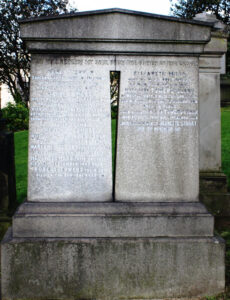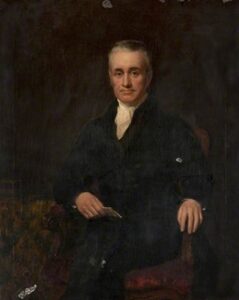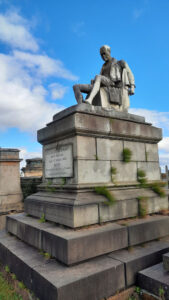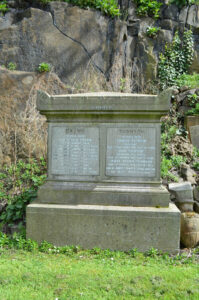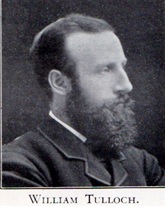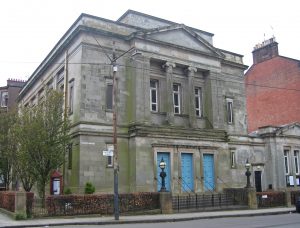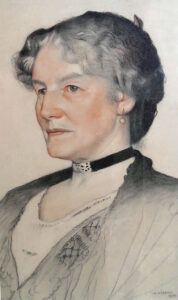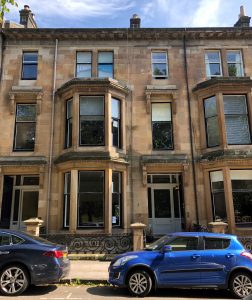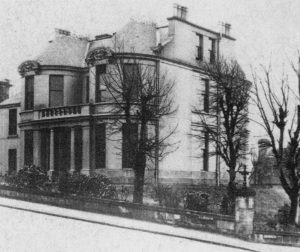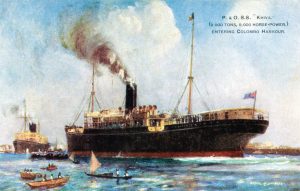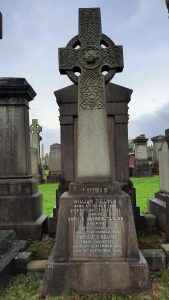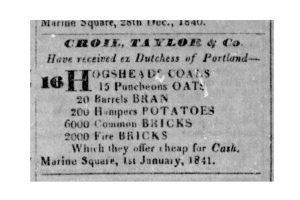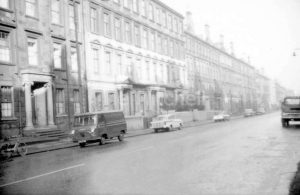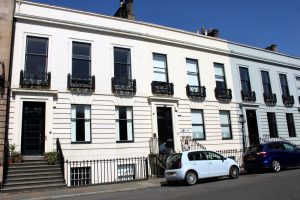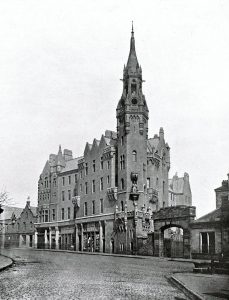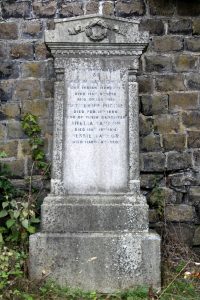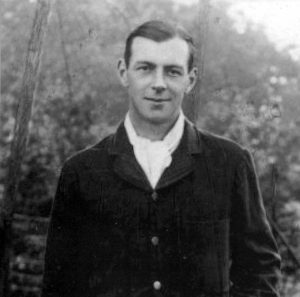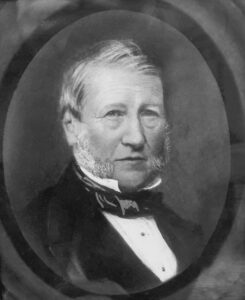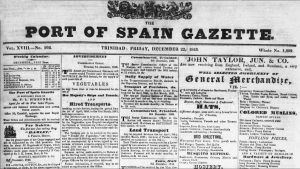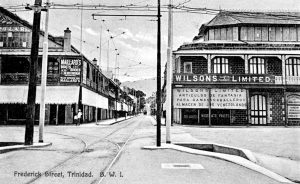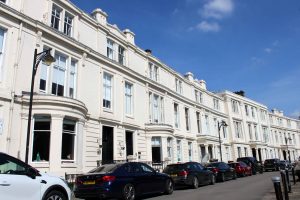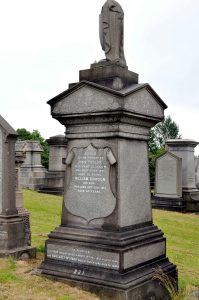Archibald Henderson Thom
Monday, October 28th, 2024Hugh Barr Thom
Monday, October 28th, 2024James Towers (1757-1820)
Sunday, November 12th, 2023by Colin Campbell
James Towers was born in 1757 on a farm near Dunblane which was then in Perthshire (now in Stirlingshire)
Although he studied medicine at the University of Edinburgh he never graduated MD. He gained surgical experience at Edinburgh Royal Infirmary and after a period in London, he came to Glasgow and joined the staff of Glasgow Royal Infirmary. He joined the Faculty of Physicians and Surgeons of Glasgow in 1787.
In 1792 he set up a “Lying-in Hospital” (a Maternity Hospital) in the City. It is not known where this was, but it was the first in the City and continued for some years financially supported by the University and later by the City Council. It is not known when it closed. The emphasis in this Hospital was on teaching.
Despite not having taken an MD, he was appointed the first Professor of Midwifery at Glasgow University in 1815. In 1817, the University conferred on him and others the controversial degree of CM (Chirurgiae Magister), the first ever issued by a British University. The introduction of this degree was to lead to years of confrontation with the FPSG who claimed exclusive rights to issue licenses for the practice of surgery.
James married Helen McIlhose in 1790.
He died on 24 July 1820, aged 63 at his home at 56 Ingram Street, Glasgow. He was buried in the Ramshorn Churchyard and is commemorated in the Necropolis.
Charles Tennant (1768-1838)
Thursday, November 9th, 2023by Colin Campbell
Charles was born on 3 May 1768 at Alloway in Ayrshire to John Tennant and Margaret McClure one of thirteen children. He was educated at Ochiltree Parish School.
His father initially apprenticed him to be a handloom weaver.
In 1795 he married Margaret Wilson in Paisley. They would have ten children.
The growth of the textile industry in Britain in the late 18th century was hindered by the long delay in bleaching cloth. Due to his being a weaver, Charles became interested in the bleaching process. He perfected the technique of using chlorine and lime to produce highly effective chlorine bleaches and the production of bleaching powder (helped by Charles Mackintosh) in 1799. He patented it that year.
In 1800 Charles founded his chemical works at St. Rollox, Springburn, Glasgow. The principal product was bleaching powder which was sold worldwide. By 1815 the business was known as Charles Tennant & Co. and had expanded into other chemicals, mining, metallurgy and explosives. The early rail network in Scotland were also areas of great interest to Charles Tennant; he greatly assisted in the securing the Act (July 1838) which would lead to the construction of the Edinburgh to Glasgow railway line.
In the 1830s and 40s the St. Rollox plant was reputed to be the largest chemical works in the world. It employed over one thousand persons and dominated the local economy.
He had founded a business empire which was to grow under his son and grandson to be of enormous wealth. His descendants became extremely well connected in British aristocratic and political circles.
Tennant died at his home at Abercromby Place in Glasgow on 1 October 1838, aged 70.
(Ack; National Galleries of Scotland (image), Britannica, NRS, Graces Guide)
James Brown Thomson and his brothers
Saturday, October 1st, 2022The newspapers throw up some interesting stories about families buried in the Necropolis. The related Brown and Thomson families share a lair in compartment Gamma in the Necropolis.
THE STORY OF A GLASGOW MISER. A FORTUNE AND LIVING ON PORRIDGE
The Glasgow Evening News of Tuesday night says that under the will of the late Mr James B. Thomson, who died the previous day in Gartnavel Asylum, the charitable institutions of Glasgow and the West of Scotland are likely to benefit. Only a few months ago Mr James B. Thomson was living in seeming poverty in a small house near Paisley Road, and investigations as to how a man in this condition of life was able to leave £100, 000 to charitable objects have opened up a history for which it would be hard in these work-a-day times to find a parallel. The family history goes back to the early years of the century, when three boys—John, James, and Thomas Thomson—were reared in humble circumstances in a house in Rottenrow. In the course of time John went into business in the city, and became in time an underwriter and a well-known figure in the Royal Exchange.
He was for many years in partnership with Mr Watson, the late City Chamberlain, and he controlled a very prosperous business. His most successful speculation, and the one which laid the foundation of the fortune which now awaits distribution, was the purchase of some property at Stobcross. In the course of time, when the docks came to be formed there, this ground increased enormously in value, and was sold to the Clyde Trust. Thomas, another of the brothers, had meanwhile gone abroad and established a large and successful trading business in Valparaiso. The third brother, James, who died on Sunday, remained in Glasgow, but his affairs went less successfully, and he worked most of his life about the docks, becoming a stevedore in a small way of business. A number of years ago Thomas returned from Valparaiso, and being unmarried, took up house with John, who was also a bachelor.
They occupied a mansion-house in the West End of the city, and their combined fortunes at this time ran to about £30,000 (sic). The two brothers made a compact then that when one of them died half of their combined possessions, about £150,000, should go to their maternal relations, whose name was Brown, and that the survivor should take the remaining £150,000. About eight or ten years ago Thomas died [7 September 1887], and under his will this agreement was carried out, and three relations of the name of Brown got each £50,000. Very soon after John also died [25 October 1887] rather suddenly, and, as he left no will, his money passed to his brother James as heir-at-law, though the other brothers had not recognised him for many years.
James was, like the others, well advanced in years at this time, and lived in Smith Street, Kinning Park. The money was made over to him, and he took possession at the same time of the house which his brothers had occupied. He went there and lived for about a week, at the end of which be left, saying it was far too expensive for him, and returned to his room and kitchen at 27 Smith Street. He had always been a little peculiar in his ways, and as the years went on his peculiarity became more marked. He shunned all society, and lived a solitary life, attended only by an elderly woman, Mrs Stuart, who kept the house for him. About two years ago his housekeeper fell ill and was compelled to leave him. He refused to allow anyone else to wait on him, shut himself up in his house, and lived in the meanest possible way. He cooked hie own food, living principally on porridge, and of which he made sufficient at a time to last him for a day two. Some of the neighbours remonstrated with him that a man possessed of money should live in this fashion, but he justified himself by arguing that it was ” very economical.” A neighbour woman got in occasionally and attempted to keep his house in fairly decent order, but he became more and more suspicious, barricaded his door, and refused to allow any one to enter.
All last winter he lived shut up in his house without a spark of fire more than was necessary to cook his pittance of porridge. His sole recreation was to go to the Mitchell Library, to which he walked every day with the idea of saving car fares, and where he sat regularly every day. His affairs were meantime in the hands of a firm of Glasgow solicitors, but he drew from them only a few shillings a week and refused to allow them to make any other arrangements for him. Last spring be had become so queer in his behaviour, and his house bad become so offensive from long neglect, that the neighbours called the attention of the authorities to the case. A sanitary inspector visited the place and found the house in a very filthy condition. They had it cleared out, and as Thomson then seemed incapable of taking care of himself an attempt was made to get him into some institution in the city.
The Old Man’s Home was tried, but it was naturally considered that being possessed of means he was not a fitting candidate for admission. Every effort was made to induce him to remove or to allow someone to take care of him, but he stubbornly resisted. He had several hallucinations, one of them being that his brother Thomas, who had then been dead for nearly ten years, used to visit him every night. He had knocked a hole in the wall separating the room and kitchen beds, and he used to lie there and carry on imaginary conversations with his brother. The parochial authorities refused to take charge of the case, and at last he was certified as insane and removed to Gartnavel Asylum, where he remained until he died. It is stated that while be himself lived in such squalid surroundings his lawyers paid, by hie directions, charities amounting to about £600 per year. The terms of the will have not yet been made public, but it is stated that the total sum left amounts to about £180,000. There are, it is said, a number of legacies to private individuals ranging from £2000 downwards, and that £100,00 is set aside for public charities.
Elgin Courant, and Morayshire Advertiser – Friday 07 October 1898
The remains of Mr James B. THOMSON, concerning whose charitable bequests rumour has been busy for the past two days, were interred yesterday in the Glasgow Necropolis beside those of his brothers and other relatives. By his will Mr Thomson has, in addition to numerous and handsome personal bequests, left the following legacies to Glasgow institutions: Royal Infirmary, £4000; Western Infirmary, £3000; Victoria Infirmary, £2000 ; Sick Children’s Hospital, £200; Institution for Deaf and Dumb, £200; Asylum for the Blind. £200; Lock Hospital, £200; Seamen’s Friends Society, £200; Night Asylum for the Houseless, £200. Further, Mr Thomson directs his trustees to divide among such charitable, benevolent, or educational institutions in Glasgow or the West of Scotland, as they may themselves select, the residue of his estate, which, it is estimated, may, after paying all prior legacies and Government duties, amount to from £60,000 to £65.000.
The Dundee Courier & Argus (Dundee, Scotland), Thursday, October 06, 1898
William Tulloch and family
Tuesday, December 28th, 2021Contributed by John Taylor Park
William Tulloch (1848-1923)
William Tulloch was born in Elgin, Morayshire on 5th March 1848. He was the first of eight children for his parents William Tulloch senior and Margaret MacDonald who had married there in June of the previous year. William’s father was a Baptist minister and was originally from Blair Athol in Perthshire, while his mother was a native of Elgin. He was joined by younger siblings Elizabeth, Margaret, Patrick, John, Alexander, Ebenezer and James between 1849 and 1860.
William spent his early childhood living at 14 Academy Street in Elgin until his family moved south to Edinburgh in 1856. His youngest three siblings were born in the capital. The family were still living in Edinburgh in 1871 when the census for that year recorded them residing at Sciennes Hill Place in the city with 23-year-old William working as a bookseller.
A change of career and location soon followed for William however when he moved to Glasgow around 1872 and became a Starch & Gum merchant. This came about after his sister Elizabeth married Starch manufacturer Allan MacDiarmid that year and moved to the Glasgow area where his business was based. William moved to Glasgow around the same time to join his new brother-in-law in the firm.
The firm was ‘James Anderson & Co’, a Starch and Gum manufacturing business with premises at Surrey Street on the south side of the River Clyde and offices at 124 St Vincent Street in Glasgow city centre. James Anderson and Allan MacDiarmid were cousins and originally from Perthshire. William became a partner in the firm after which the company changed name to ‘Anderson, Tulloch & Co’. The business then enjoyed a period of steady expansion which saw the workforce more than double to around 80 employees by 1881. The firm also established a registered office at 9 Great Tower Street in London.
Away from their commercial interests, William Tulloch and Allan MacDiarmid also combined their shared interest in the church when they were amongst the founders of the Hillhead Baptist Church on Cresswell St in 1883. Their fellow co-founders were John Alexander and Alexander & Charles Rose. The building was designed by Glasgow architect Thomas Watson who also designed the very similar Adelaide Place Baptist Church in Glasgow city centre which had opened six years previously. Hillhead Baptist church remained in continuous use until 2004 when it closed its doors for the final time. It has since fallen into a serious state of disrepair and despite the Grade B listed building status the future of the church is now most uncertain.
William became the sole proprietor of Anderson Tulloch & Co following the deaths of James Anderson in 1874 and brother-in-law MacDiarmid in 1890 and continued thus until his own death in September 1923. A new limited company of the same name was then formed by his sons William junior and John, plus his son in law Peter Rintoul, to facilitate the continuation of the business thereafter.
Sophia Crombie Taylor (1851-1923)
William’s wife was Sophia Taylor who was born in the parish of Govan on 16th July 1851. She was the second of seven children for her parents John Taylor and Margaret Simpson who had married in Glasgow in June 1849. Sophia’s Paisley born father was a successful West Indies merchant who already had seven children by his first wife Janet before her relatively early death. Sophia’s mother was from the Liverpool area and Sophia’s Crombie middle name was her Grandmother Simpson’s maiden name. Sophia was followed by younger siblings Georgina, Victoria, William, Mary and Jemima.
Sophia’s family grew up living in a large townhouse at 17 Royal Crescent in Glasgow. Sadly, Sophia suffered the loss of both her parents before she had reached the age of 15 and this resulted in her and her young siblings living with a Taylor relative for a time until she reached adulthood. The siblings later moved together into ‘The Anchorage’, a substantial detached villa at 4 Kirklee Road (originally 2 Kirklee Avenue) in Kelvinside.
Baptist church links and a wedding
William and Sophia were married on 1st September 1875 at Sophia’s Kirklee Road home in Kelvinside, with William’s brother Patrick and Sophia’s sister Georgina acting as their witnesses on the day. William had been living at 509 Sauchiehall Street in the Charing Cross area of the city prior to their marriage.
It seems quite possible that William and Sophia had met through Baptist church connections. William’s father and Sophia’s Grandfather had both been Baptist ministers so both families had strong links to the church. William would later be acknowledged as one of the co-founders of Hillhead Baptist Church mentioned above, and both he and Sophia would play major parts in the day to day work of the church itself.
Family additions and moves
William and Sophia began married life living at 2 Ashton Terrace (now 3 Ashton Road) in Hillhead. They soon began to raise a family and their first child William junior was born the following year in 1876. Their first daughter Margaret arrived a year later and she was followed by John in 1879. The family then moved to Sophia’s previous home at Kirklee Road in 1880 and daughter Sophie Evelyn was born there the following year.
The 1881 census recorded the young Tulloch family on a Spring holiday break at ‘Ashcraig’ on Shore Road, Cove on the shores of Loch Long. They had three children by this time, and young Sophie would be born later that year in September.
The family moved home again in 1884, this time to the pleasant surroundings of 41 Athole Gardens in Hillhead, and this large townhouse would become the family home for many years to come.
The final addition to the Tulloch family was daughter Hilda who was born at Invercloy, Brodick on the Isle of Arran in June 1884. Hilda’s birth record gives the Tulloch’s new Athole Gardens address, indicating they were most likely taking a summer break on Arran when she was born. It seems certain that Hilda became the most unique holiday souvenir the family ever returned home with.
All but one of the Tulloch family were at their Athole Gardens home in the 1891 census. The missing family member was William junior who was attending the Leys boarding school at Cambridge at the time. He had two of his MacDiarmid cousins for company at the school. An electoral roll for the following year recorded Athole Gardens as William’s residential address along with his St Vincent Street business address and his ‘Starch manufacturer’ occupation.
In 1900 the family moved once again, this time to ‘Dariel’, a large villa at 62 Montgomerie Drive in Kelvinside, and it was here that William and Sophia would live for the rest of their lives. In the 1901 census all the family are living at the new family home including William junior who had returned from Cambridge and was now working in the family business as a clerk. This address would later become 62 Cleveden Drive as part of a major street renaming exercise in the Hillhead area.
The growing family eventually began to go their own ways in the world and by 1910 William junior, Margaret and John had all married and left the family home. Sophia and Hilda continued to live at home at ‘Dariel’ however and this arrangement would continue right through until the end of 1923. An electoral roll for that year recorded Sophia and Hilda both still living at home.
William Tulloch passed away at home on 21st September 1923 at the age of 75 and was interred in the Tulloch family lair at the Necropolis. Sophia passed away at their Montgomerie Drive home less than three months later on 11th December aged 72 and was laid to rest beside her husband.
The subsequent lives of the Tulloch family children are summarised below.
William Forbes Tulloch (1876 – 1948). William married his wife Margaret Farquhar at Hillhead Parish Church in 1910. They appear to have had two children, Margaret and Evan. During WW1 William served as a Captain in the 2/3rd Battalion of the East Riding Volunteer Regiment. His family were living at Sevenoaks in Kent by 1924 but they moved to the Knightsbridge area of London later that year. That same year William formed a limited company with his brother John and brother-in-law Peter Rintoul to facilitate the takeover of his late father’s business interests. William became a Stockbroker and was a director of the London Stockbroking firm Quilter & Co until he retired from that company in 1931. William and Margaret had moved to Windmill Hill House in Hampstead by 1939, an area popular with other Tulloch, Taylor, and MacDiarmid relatives, and they lived there until William passed away in 1948 aged 71. Margaret died in Kensington in 1972 aged 84.
Margaret MacDonald Tulloch (1877 – 1945). Margaret married her Bothwell born husband Peter Rintoul in Partick in 1904. They had five children, Margaret, Robert, Andrew, Barbara and Peter, and lived at ‘Kildowan’, a large property at 13 Victoria Circus in the Dowanhill area of the city. Peter was a most successful Chartered Accountant who became senior partner in the firm of ‘Graham, Rintoul, Hay, Bell & Co’ of 105 St Vincent Street in Glasgow. He was also on the board of the Union Bank of Scotland, Scottish Amicable Life, and various investment trusts. He had also been secretary of the Glasgow Royal Infirmary from 1908 to 1915. Peter died at Kilbryde Castle by Dunblane, where they had a summer residence, in 1933 at the age of 63. Margaret later moved to the Hampstead area of London and lived at 34 Ellerdale Road in the borough close to other relatives. She passed away there in 1945 aged 68. Both are commemorated on the Rintoul family headstone at the Necropolis.
John Taylor Tulloch (1879 – 1943). John played rugby for Kelvinside Academicals and later served as SRU president in 1906-7. He married his wife May Rose at Hillhead Baptist Church in 1909. They had three children, William, Alexander and Elizabeth, and lived at 11 Mirrlees Drive in Kelvinside. He saw action at Gallipoli during WW1 while serving as a Captain in the 5th Batt Highland Light Infantry and was awarded the Military Cross in 1917. John became a successful Chartered Accountant based at 209 West George Street in Glasgow and worked with several financial institutions including the firm of his brother-in-law Peter Rintoul. He was made a Justice of the Peace for Glasgow in 1928. His family had moved to 10 Huntly Gardens in Hillhead in 1923 and they were still at the same address by 1938. They later moved to Ayr and resided at 35 Monument Road until John passed away in the town in 1943 aged 64. May survived him by 16 years until she passed away in 1959, also in Ayr.
Sophia Evelyn Tulloch (1881 – 1932). Sophia remained single throughout her life and lived at the family’s Montgomerie Drive home until the loss of her parents at the end of 1923. She appears to have been known by her middle name Evelyn from around 1900 until 1923 and is listed in records as Evelyn or Evelyn Sophia during this period. She had reverted back to Sophia the following year when she embarked on an extended tour of the Far East.
She travelled outward from London to Singapore in November 1924 aboard the P&O liner ‘Khiva’, returning to London seven months later when she joined the ‘Khyber’ at Colombo in what was then Ceylon (now Sri Lanka). The passenger list for her return voyage indicates she intended to reside in England upon her return. Sophia was residing at ‘Tomdhu’ in Peasmarsh in East Sussex by 1932, but she died later that year at the Devonshire Court Hotel in Eastbourne aged just 51. She is commemorated on the Tulloch memorial at the Necropolis.
Hilda Elizabeth MacDiarmid Tulloch (1884 – 1941). Hilda also remained single and never married. The 1911 census found her studying agricultural methods at Mercia Smallholdings at Hollingbourne in Kent, but she returned thereafter to live at the family’s Montgomerie Drive home until the loss of her parents at the end of 1923. Hilda then moved to 5 Cranworth Street in the Hillhead area and was still listed at that address in an electoral roll for 1940. Tragically, Hilda lost her life the following year at the hands of Nazi forces at Skredsvik on the west coast of Sweden in July 1941. The award winning Arolsen Archives confirm Hilda’s personal details but no other information is available regarding the circumstances of her death.
Sources
The following sources have been invaluable in providing some of these details and are gratefully acknowledged here:
The British Newspaper Archive website
The National Records of Scotland and the excellent ScotlandsPeople website.
Morag Fyfe at the Friends of Glasgow Necropolis website for accessing the Necropolis database.
Ann Muir, church secretary, Hillhead Baptist Church
Arolsen Archives
Links
https://en.wikipedia.org/wiki/Hillhead_Baptist_Church
http://www.hillheadbaptistchurch.co.uk/
https://en.wikipedia.org/wiki/Thomas_Lennox_Watson
https://en.wikipedia.org/wiki/The_Leys_School
JOHN TAYLOR, JUNIOR (1815-1878)
Wednesday, November 10th, 2021Contributed by John Taylor Park
Formative years
John Taylor, junior was born in Paisley on 19th May 1815, the first of seven children for his parents John Taylor (senior) and Janet (Jessie) Barr. His parents were both from Paisley and had married there in July of the previous year. His Grandfather (also named John Taylor) was a co-pastor at the Storie Street Baptist Church in the town during the first half of the 1800s.
Younger sisters Margaret and Elisabeth came along after John, after which the Taylor family moved from Paisley to the Gorbals area of Glasgow sometime between 1820 and 1825. Following this move, John gained four Glasgow-born siblings in Jean, Agnes, Janet and Thomas.
The Trinidad years
Employment led John to pastures new when he began working for the Croil family of Glasgow as a West Indies merchant. He left Glasgow sometime between 1835 and 1840 to live at Port of Spain on the island of Trinidad. This proved to be a most successful move for him and he went on to become a partner in the business.
By 1842 John was listed as a Port of Spain Burgess living at Kings Wharf.
John married his wife Catherine Michie at Port of Spain in Trinidad on 17th June 1842. The Michie family were originally from the Milton area of Old Kilpatrick but they had moved to Partick by 1841 when the census for that year recorded Catherine still living at home with her family.
It is not clear how John and Catherine actually met each other. They grew up on opposite sides of the River Clyde and by 1841 were living and working on opposite sides of the Atlantic. Their paths would not have crossed often but they may have met during one of John’s occasional business trips back to Glasgow. Another possibility is that the minister who married them, a “Rev Mr Kennedy”, shared the same surname as Catherine’s mother’s family and may have been related to Catherine. Perhaps it was John’s connection to the Baptist church in Trinidad which brought them together.
Two months after their wedding news arrived from Scotland that John’s mother Janet had passed away in Glasgow. This sad event would ultimately bring about major changes for John and the rest of the Taylor family.
This loss prompted John and his father (John senior) to form a business partnership together trading as West Indies merchants. His father subsequently moved to Trinidad the following year along with most of the Taylor family, and the Croil Taylor partnership was dissolved in August 1843 ahead of the two men forming their new business. The new business traded as “John Taylor, Junior & Co” and had become well established at Port of Spain’s Marine Square before the end of that year.
The father and son business appears to have been hugely successful during the following six years. There were a surprising number of Scots trading as merchants in Trinidad at this time and the two men developed close business links with a number of them. A few would become trusted life-long friends and business associates, while three of them became part of the family when they married John’s sisters Elisabeth (Alexander Taylor), Agnes (James Wilson), and Janet (William Graham).
With John and Catherine now settled in Port of Spain and John’s business interests performing well, they began a family of their own and were initially blessed with three children. Their first child John was born in 1843 while daughter Catherine arrived towards the end of the following year. Isabella arrived in 1846, however she appears to have travelled from Trinidad to Glasgow at a very early age and may have had health problems. Sadly, Isabella died in Glasgow at just a year old and she was buried at the Necropolis on 11th September 1847.
Isabella’s early death had brought about an urgent need for a family burial plot and this resulted in John purchasing one half of a large lair from a Todd family of Glasgow. There was a merchant by the name of James Todd trading in Trinidad at this time who may have been part of this family, and if so it seems possible that he and John knew each other and that this connection led to the divided lair agreement. The outcome found John owning a family lair some years ahead of his father John Taylor senior, who later purchased his own family lair in another part of the Necropolis. It seems a little bit unusual that father and son did not co-operate and jointly purchase a large lair to share or subdivide.
Return to Scotland
1849 brought about substantial business and family changes for John. His father’s personal circumstances had now changed and he would return to Glasgow and marry his second wife Margaret Simpson later that year. Possibly because of this, the two men decided to end their business partnership and trade independently of each other. Their partnership was formally dissolved on 15th May.
John and Catherine took the decision to relocate back to Scotland around the same time. They returned to Glasgow and settled initially at 22 Abbotsford Place in the Gorbals. John continued to trade as a West Indies merchant and set up business premises at 28 Cochrane Street in the city, sharing the premises and business links with his brother in law Alexander Taylor who had also returned to Glasgow to take over his own family’s Calenderer business.
Busy times in Glasgow
Once John and Catherine were settled back in Glasgow their young family began to expand again and son Thornton arrived in the spring of 1850. The 1851 census captured the family together at Abbotsford Place on 30th March, with children John and Catherine recorded as scholars and baby Thornton recorded very precisely at 10 months old. This family scene changed abruptly only two weeks later when Thornton died of Bronchitis. He was buried at the Necropolis on 14th April.
Shortly after this the family moved to the grander surroundings of 3 Newton Place, a large terraced townhouse situated just off Sauchiehall Street immediately west of Charing Cross.
This large house would become a busy home over the next few years as John’s family grew once again. Eliza was born in 1853, Amelia in 1855, Jessie in 1857, and finally Helen in 1859.
While his own family was growing John also gained a number of half-siblings following his father’s second marriage. John senior lived a short distance along Sauchiehall Street at Royal Crescent.
John continued with his own merchant business but became increasingly involved in local civic matters. He became a city councillor in the early 1850s and went on to serve on the council for over 25 years. He was appointed depute River Bailie in 1853, becoming River Bailie the year after. He became a magistrate in 1855 and served a full three year term. He was appointed again in 1865 but this time served only one year in office. He also served at different times on the Gas Committee and Water Committee, and was chairman of the Finance Committee for a number of years.
In addition to his civic duties, he was also a director of the Glasgow Blind Asylum on Castle Street and a preceptor at Hutchesons Hospital on Ingram Street. The Blind Asylum building is now part of the Royal Infirmary while Hutchesons Hospital (Hall) has undergone a number of reincarnations but is now looking for a new occupant (2021) since the restaurant in it failed to reopen after the COVID lockdowns.
John’s merchant business broadened its horizons during this period. A newspaper notice in 1873 advertised that he had been “Actively engaged for the last 30 years in the West Indian Dry Goods Trade” and illustrated the fact that his trading connections now extended beyond Trinidad to include Barbados, Grenada, and Demerara (then part of British Guiana).
Family changes
The first of John’s children to marry was his son John, who wed Christina Primrose Shaw in Glasgow in July 1865. Daughter Catherine made it two family weddings in quick succession when she married John Renison four months later, also in Glasgow.
John lost his father the following year when John senior passed away in February. He was buried at the Necropolis on 12th of that month, but the year ended on a much happier note when young John and Catherine both presented him with the first of his Grandchildren, born just four months apart.
A further family wedding took place in October 1873 when daughter Eliza married James Reid in Glasgow, but tragedy struck the following year when Eliza died a week after the birth of her first child. She was just 21. Eliza was the third child John had lost during his lifetime.
John suffered a severe bout of Bronchitis in early 1876 which resulted in him most unusually being laid up for a spell, and although he recovered and resumed his many business and civic duties he suffered from the disease at regular intervals thereafter. A further setback came later that year when his brother in law and close associate Alexander Taylor passed away at Shawlands.
In the end
Two years later John fell ill after returning home from a meeting of trustees at Hutchesons Hospital. His condition steadily worsened and he passed away two days later on 9th May 1878 at home at the age of 62. He was laid to rest at the Necropolis on the afternoon of Monday 13th May. The following day the Glasgow Herald reported a large attendance at his funeral service including the Lord Provost, magistrates, and members of the city council and Hutchesons Hospital. It also reported the bells of the city’s churches, and that of the hospital, tolled in the forenoon prior to the service.
John’s will thoughtfully took care of his surviving family, while the John Street Baptist Church in the city centre was another beneficiary of his estate. His accounts revealed a substantial debt incurred as a result of his son John’s overseas business failing although the precise details were not given. John’s will included an option for his son to take over his merchant business upon his demise, and a Glasgow Herald notice in November 1878 six months after his death confirmed this had taken place.
John’s surviving family
Wife Catherine outlived John by less than two years and she passed away on 12th February 1880 in Glasgow at the age of 66. She was laid to rest at the Necropolis four days later. Catherine’s parents, George and Catherine Michie, had been buried in the Taylor family lair in 1849 and 1864.
Son John and his wife Christina Primrose Shaw had five children and lived most of their married lives at Sardinia Terrace (now Cecil Street) in the Hillhead area of Glasgow. He also became involved in overseas trading but his business suffered some considerable losses which led to his firm going into liquidation. He described himself as a “West Indies merchant” in the 1881 census three years after taking over his late father’s business, but reverted back to a “Commissions clerk” in all subsequent returns. He passed away at home in Hillhead on 5th March 1910 at the age of 66 and was buried in the Shaw family lair at the Necropolis. Christina died in South London in January 1927 and was laid to rest beside John.
Daughter Catherine and her husband William Renison had nine children and lived most of their married lives at Hillsborough Square on Bruce Street (now Bower Street) Hillhead. Gorbals born William owned a Power Loom manufacturing business, Renison, McNab & Co, which was based at Hozier Street (now Queen Mary Street) in Bridgeton and employed several hundred staff. He later sold the business and by the 1901 census had become a fine arts dealer. He died in January 1915 at Hillhead and was buried in the Renison family lair at the Necropolis. When Catherine passed away at Hillhead on 4th April 1930 she was 85 years old and had become John’s last surviving child. She was laid to rest beside William.
Amelia never married but appears to have been well travelled. Census records often find her in other parts of the country “living on private means”, usually in the company of sisters Jessie or Helen. The 1911 census recorded her staying at the Royal Hotel at Babbacombe in Devon with Helen and her family. Her usual residence was at Redwood Mansions on Elliot Street (now Cresswell Street) in Hillhead. Amelia passed away at home on 19th May 1916 at the age of 61 and was laid to rest beside her father at the Necropolis three days later.
Jessie also remained single and never married. Like Amelia, she also appears to have been well travelled while “living on private means”. The 1891 census recorded Jessie and Amelia together at Abington Villa in Moffat, Dumfriesshire with Helen’s children although Helen herself was not present at that time. Jessie died on 9th March 1920 in London aged 62 and she too was laid to rest beside her father at the Necropolis four days later.
Helen married Donald MacLeod at the Taylor’s Newton Place home in April 1879 a year after John’s death. Glasgow born Donald had been working for John at the time of his passing. They had six children and raised their family at Bearsden near Glasgow before later moving south to the Birkenhead area. The MacLeod family also maintained a London residence in South Kensington. Donald founded a successful tobacco importing business “MacLeod, Reid & Co” which had premises in Glasgow, Liverpool and London. Donald died at their South Kensington home in May 1927, while Helen passed away just eight months later on 5th January 1928 at Torquay in Devon at the age of 68.
A famous Grandson
John’s eight children produced a total of 21 Grandchildren but sadly he did not live to see all of them. One of them in particular went on to achieve great things and is worth a mention here.
Helen’s youngest son Kenneth MacLeod found fame as “Scotland’s Greatest Sporting All-rounder”. He was a remarkable character who performed at a very high level in athletics, cricket and rugby, achieving the prestigious “Blue” status in each of these three sports during his time at Cambridge University. He was also a keen footballer and golfer with a handicap of 3.
He was an excellent rugby player and was first capped for Scotland at the age of 17 while attending Fettes College in Edinburgh. He went on to win a further nine caps for his country before giving up rugby at the age of 21.
He played cricket for Fettes College and Cambridge University before going on to play first class cricket for Lancashire County Cricket Club. He was considered one of the finest fielders in English County Cricket of his day and was also well known for his big hitting at the crease.
His athletics abilities lay mainly in sprint and long jump but he also competed in other classes. He dominated in these during his time at Fettes and went on to produce some Olympic standard performances during his Cambridge career. He set a number of records at each establishment.
After a relatively short sporting career he went on to lead a very full and colourful life and was married a remarkable five times. He passed away at his home in South Africa in 1967 at the age of 79. He was inducted into the Scottish Sports Hall of Fame at a ceremony in the City Chambers in Glasgow in 2010.
Sources
The following sources have been invaluable in filling in some of these details and are gratefully acknowledged here:
The Mitchell Library website for their “Glasgow Story” series of articles.
The National Records of Scotland and the excellent Scotlands People website.
The British Newspaper Archive website
Susan Taylor of the Guildford and District Philatelic Society for her extensive knowledge of the history of Trinidad and archive material available.
Morag Fyfe at the Friends of Glasgow Necropolis website for accessing the Necropolis database.
John W Keddie for his book “Then came a cloud, the story of KG MacLeod”, published by Scottish Sporting Heritage Publications in 2016.
Links
John Taylor, junior https://www.theglasgowstory.com/image/?inum=TGSA00198&t=2
Port of Spain https://en.wikipedia.org/wiki/Port_of_Spain
Glasgow Blind Asylum https://www.theglasgowstory.com/image/?inum=TGSA05227
Hutchesons Hospital https://www.theglasgowstory.com/image/?inum=TGSA01086
Kenneth MacLeod https://sshf.sportscotland.org.uk/inductees/l-p/kenneth-grant-macleod/
John Taylor, Senior (1792-1866)
Monday, September 20th, 2021Contributed by John Taylor Park
The early years
John Taylor was born in Paisley on Tuesday 3rd April 1792 and was the first of a large family for his parents John Taylor and Elizabeth Lang. John and Elizabeth were both Paisley natives and had married there in May of the previous year. Younger siblings Thomas, Agnes, Hugh, William, Elisabeth, Margaret, James, and Janet would follow John’s arrival. His father, a weaver to trade, was also a long serving co-Pastor at the Storie Street Baptist Church in the town during the first half of the 1800s.
John was 22 years old when he married Janet Barr (known as Jessie) on 17th July 1814 at Paisley. Janet was also Paisley born, however both her parents were originally from nearby Kilmacolm.
John and Janet’s family soon began to grow, with John junior born in 1815, Margaret in 1817, and Elisabeth in 1819. The Taylor family then moved from Paisley to Glasgow at some point between 1820 and 1825, after which they had a further four children, Jean in 1825, Agnes in 1827, Janet in 1829, and finally Thomas in 1831.
The 1841 census recorded the Taylor family living at Apsley Place in the Gorbals district of Glasgow. John is described as a Shawl Fringer, a skill no doubt gained from the extensive textile industry in his native Paisley. The family are all still living together at this time apart from eldest son John who had left Scotland to work in Trinidad about a year earlier.
The following year 1842 brought contrasting fortunes for John and his family. The first of his children married in June of that year when John junior wed Catherine Michie of Old Kilpatrick at Port of Spain in Trinidad. However, this happy event was countered with sadness less than two months later when John’s wife Janet died in Glasgow on 12th August at the age of 48.
The Trinidad era
Following this loss John embarked on a remarkable change of career which would bring about profound changes for both him and his family. John senior and junior formed a business partnership in 1843 to trade as West Indies merchants based in Trinidad. John junior had already established himself there as a merchant, working initially for the Croil family of Glasgow before going into business for himself.
It seems likely that John and his family moved to Trinidad at this time and lived there until 1849. Their merchant business had trading links with Glasgow, Liverpool and other UK ports so he would likely have spent time in both Trinidad and the UK, but family events seem to suggest he was based mainly in Trinidad during this period. The only family member not to have moved to Trinidad was his eldest daughter Margaret, who remained in Scotland and married Carmunnock farmer George Park in October 1843.
The father and son merchant business appears to have been hugely successful during this six year period. There were a surprising number of Scots trading as merchants in Trinidad at this time and the two men developed close business links with a number of them. A select few would become trusted life-long friends and business associates, and in some cases part of the family.
This was the case when John’s daughter Agnes married Edinburgh born merchant James Wilson at Port of Spain in April 1847. James was a most capable individual who was working for the Taylor family business at the time, and he appears to have become John’s trusted right-hand man in both business and family matters right up to and beyond John’s death.
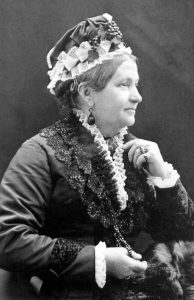
Agnes Taylor, wife of James Wilson
with thanks to Donald Meek http://meekwrite.blogspot.com/2016/04/north-bantaskin-forgotten-falkirk.html
Return to Scotland
1849 proved to be another eventful year bringing about significant changes for John and his family. John’s personal circumstances were about to change and this was probably the main reason for him returning to Scotland on a permanent basis. He married his second wife, a Margaret Simpson of Liverpool, on 5th June 1849 in Glasgow, with his Baptist minister father performing the marriage ceremony.
John continued to trade with Trinidad as a merchant, with his business now based at 19 Cochrane Street in the Merchant City area of Glasgow. John junior also returned to Glasgow around this time and he too continued as a West Indies merchant, however the father and son business partnership was dissolved in May of that year and they began trading independently of each other.
While most of John’s family also returned to Scotland around this time, his two youngest children Janet and Thomas opted to remain in Trinidad. Janet would marry Falkirk born merchant William Graham at San Fernando in October of that year, while Thomas had since become an established merchant in his own right.
This eventful year was drawing to a close when a third family wedding took place. John’s daughter Elisabeth married Glasgow born merchant Alexander Taylor at Govan in December. Alexander had become a close friend and business associate of the Taylors whilst in Trinidad and these close links continued back home in Glasgow after their return from the island.
New beginnings
Once John was settled back in Glasgow a second family with new wife Margaret soon followed with David born in 1850, Sophia in 1851, Georgina in 1852, Victoria in 1854, William in 1856, Mary in 1858, and finally Jemima in 1860.
While this would have been a particularly happy period for John and Margaret, this happiness was tinged with sadness when young David died at only 3 years old. Fate was also less than kind to the two children from John’s first family who had remained in Trinidad. First came news that daughter Janet had lost her merchant husband William Graham when he died in November 1854 whilst on passage from Trinidad to Glasgow. Two years later John learned that his son Thomas had died in Trinidad on 26th August 1856 aged just 25. And further tragedy followed when Janet, who had since returned home to Scotland and married ship owner Thomas Whyte of the Clyde Shipping Co at her father’s home in July 1858, died at Govan on 11th December 1860. She was just 31 years old.
The 1861 census recorded John’s family living in very pleasant surroundings at 17 Royal Crescent in Glasgow, part of an elegant crescent shaped row of substantial terraced townhouses set back from the road near the Kelvingrove end of Sauchiehall Street. This category B listed building was designed by notable Glasgow architect Alexander Taylor (no relation) who was responsible for a number of other stylish dwelling houses built in Glasgow during the 1830s and 1840s. Royal Crescent was completed around 1849 and survives in a largely unaltered and well maintained condition today.
Sudden endings
This snapshot in time of John’s young family at home would change less than three years later when his second wife Margaret died unexpectedly at Dunoon on the 15th October 1863 at the age of 43. Margaret’s passing left behind John with their six young children, the youngest of which was Jemima at just three years old.
Further change came about all too soon when John died suddenly less than three years later aboard a train at Bridge Street station in Glasgow on the afternoon of Wednesday 7th February 1866. He was 73 years old. He was laid to rest at the Necropolis in Glasgow five days later on Monday 12th.
The success of his West Indies merchant business became apparent in the extensive estate he left behind. He had set up a trust to ensure that all of his surviving children maintained a comfortable and well supported way of life upon his demise. This extended out to include his Grandchildren and other relatives, particularly those less fortunate than others, who would also benefit from his legacy. A number of institutions in his native Paisley including the Old Weavers Society and the Storie Street Baptist Church also benefitted, as did the Glasgow Royal Infirmary.
John’s first family in later life
The surviving children from his first marriage had all settled comfortably in and around the Glasgow area with their families after the highly successful Trinidad era of the 1840s, and those who had been involved in Trinidad business continued to trade with the island.
John junior and his family lived just a short distance from his father at Newton Place in the Charing Cross area of the city. He became a magistrate and a long serving councillor but continued to trade as a West Indies merchant until he passed away at home on 9th May 1878 aged 62. He was buried at the Necropolis in a family lair of his own four days later.
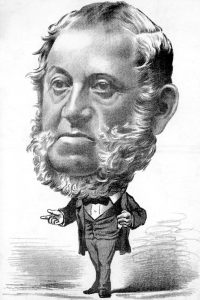
John Taylor, junior from https://www.theglasgowstory.com/image/?inum=TGSA00198&t=2
Margaret’s family moved away from their Carmunnock farm to live in the Kinning Park area on the south side of Glasgow. They later moved to Cathcart before Margaret spent much of her later years living at Royal Street in Gourock. She survived her husband by seventeen years and died at Mount Florida on 4th March 1895 at the age of 77. She was laid to rest beside her father three days later at the Necropolis.
Elisabeth and her family lived in the Shawlands and Eastwood areas south of Glasgow after their return from Trinidad and subsequent marriage. Elisabeth’s husband Alexander Taylor continued to have close business links with John senior and junior through his Calenderer business. Elisabeth was the last surviving member of John’s first family when she died in Glasgow on 2nd February 1908, aged 88.
Jean did not keep in the best of health throughout her life and died in Glasgow just nine months after her father on 17th November 1866 at the age of 41. She was also laid to rest beside him at the Necropolis.
Agnes and her family eventually settled at Trinidad Villa on Paisley Road in the burgh of Govan. Her husband James Wilson was a particularly successful gentleman: he became a Police Commissioner for the Govan force in 1865 and later became Provost of Govan from 1872-1880. He also served as one of John Taylor’s trustees, and appears to have taken over much of John’s business interests upon his death. The Wilson’s later retired to the extensive Bantaskin Estate at Falkirk, where Agnes passed away on 2nd February 1892 aged 65. James died there in 1904.
John’s second family in later life
John’s surviving children from his second marriage to Margaret were still at a young age when he died. Five years after his death, the 1871 census recorded Sophia, Victoria, Mary, and Jemima living with relative Jessie Park at 139 West Campbell Street in Glasgow city centre. The same census recorded Georgina and William attending boarding schools in Brighton and St Andrews respectively. By 1873 the siblings had moved into a substantial new villa together at what is now 4 Kirklee Road in Kelvinside (2 Kirklee Avenue when built) where they lived until most of them married. The trust set up by John which included James Wilson as one of the trustees appears to have ensured his second family were well educated and lead to them having successful adult lives.
Sophia married Elgin born merchant William Tulloch at her Kelvinside home in September 1875. Both families had strong links to the Baptist Church, and Sophia and William played a major part in the founding of Hillhead Baptist Church in 1878. They raised their family in Hillhead, residing at 41 Athole Gardens for many years before moving a short distance to 62 Montgomerie Drive (now Cleveden Drive) in Kelvinside in 1900. Sophia passed away at her home on 11th December 1923 at the age of 72, less than three months after her husband. They were both interred in the Tulloch family lair at the Necropolis.
Georgina married Paisley born Doctor Joseph Coats, who was part of the famous Coats family, at her Kelvinside home in December 1879. Their first family home was at 7 Elmbank Crescent, later moving to Lynedoch Street and then University Gardens when Joseph became Professor of Pathology at the University of Glasgow. The Coats also had strong Baptist Church connections and Georgina and Joseph were closely involved with the Adelaide Place Baptist Church in Bath St where Joseph became Deacon. Following Joseph’s untimely death in 1899 Georgina moved to the Hyndland area of Glasgow and lived there until she passed away on 19th June 1927 aged 74 while on holiday at Pitlochry. She was buried in the Coats family lair at the Necropolis.
Victoria died at just 19 years of age at Valetta, Malta, on 20th December 1873. She had been suffering from poor health and had travelled to the island with sister Georgina in the hope of improving her health but she sadly succumbed to her illness whilst there and was buried on the island. She is commemorated on her father’s gravestone at the Necropolis. She is also remembered in a large stained glass memorial window at the Adelaide Place Baptist Church on Bath Street in Glasgow which the Taylor family attended. The window was raised by James Wilson when the church first opened in 1877. The church and the memorial window both survive to this day.
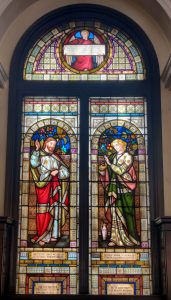
The memorial window given to Adelaide Place Baptist church by James Wilson in memory of his sister in law Victoria Taylor (by permission of Emma Boyd of APBC.)
William married Mary Robertson of Dunfermline in her home town in 1882. The family were well travelled, with their three children born as far apart as Glasgow, New Zealand, and South London. The 1911 census recorded William as a partner in a General Colonial Agents firm and living in the West Hampstead area of London. William died suddenly at Westgate on Sea, Kent on 22nd August 1913 at the age of 56, and was buried beside his father in the Necropolis five days later.
Mary married Indian born bank accountant George Bennett at the Coats family home on Lynedoch Street on 30th October 1889. Mary’s family were recorded living at Baillieston in the 1901 census but they subsequently moved to nearby Bothwell. Mary outlived both her husband George and only son John, and later moved to Callander in Stirlingshire where she lived until she passed away on 28th June 1940 aged 81. She was buried at Callander.
Jemima married Dunfermline born John Robertson on 29th April 1884 at the Coats family home on Elmbank Crescent. Jemima’s husband John was a linen manufacturer, and his sister Mary Robertson had married Jemima’s brother William two years previously in Dunfermline. The couple raised their family in Dunfermline and subsequently lived there all their lives until Jemima passed away at home on 16th May 1944 at the age of 83. She was the last surviving child of John Taylor.
Grandchildren and subsequent John Taylors
John had a total of fourteen children by his two marriages and a remarkable forty two grandchildren. Recurring names is a regular feature for many families and the Taylor family were no exception. Two of his Grandchildren were christened “John Taylor” while another five became “John Taylor ______”. The name has subsequently continued through several generations and the writer of this article is the fourth successive John Taylor Park, all direct descendants of John’s eldest daughter Margaret.
Sources
While the basic outline of the story including the family connection to Trinidad had been passed down through family generations, much of the finer detail including dates and locations had been lost through the passage of time. The following sources have been invaluable in filling in some of these details and are gratefully acknowledged here:
The National Records of Scotland and the excellent Scotlands People website.
The British Newspaper Archive website
Susan Taylor of the Guildford and District Philatelic Society for her extensive knowledge of the history of Trinidad and archive material available.
Sheila Riach at the Adelaide Place Baptist Church in Glasgow.
Morag Fyfe at the Friends of Glasgow Necropolis website for accessing the Necropolis database.
Christine Lumsden for her chapter entitled “Her Children Arise and Call her Blessed: the Place of Women in Scottish Baptist life” in A Distinctive People: a Thematic Study of Aspects of the Witness of Baptists in Scotland in the Twentieth Century, edited by Brian Talbot, 2014.
See also
John Taylor junior (not senior) https://www.theglasgowstory.com/image/?inum=TGSA00198&t=2
James Wilson https://www.theglasgowstory.com/image/?inum=TGSA00132#:~:text=Mitchell%20Library%2C%20The%20Bailie&text=James%20Wilson%20was%20Provost%20of%20Govan
Port of Spain https://en.wikipedia.org/wiki/Port_of_Spain
San Fernando https://en.wikipedia.org/wiki/San_Fernando,_Trinidad_and_Tobago
John Tait
Saturday, June 25th, 2016John Tait, a weaver by trade and editor, printer and publisher of the Glasgow Liberator from November 1832 until his death in 1836, is buried in common grave number 2 in Compartment Zeta. He died on the 19th October 1836 aged 41 from typhus leaving five orphaned children (his wife had died only a few months previously) and was buried on 24th October. He received a public funeral which was “attended by at least 2000 persons respectably dressed in mourning” according to newspaper reports. His was the first of 257 interments in this grave between then and 6th April 1840.
The Glasgow Liberator, November 1832 to October 1836, was one of a number of short-lived radical newspapers that sprang up in the 1830s during the struggle for Parliamentary reform and improvements to the rights of working men. It developed from the Herald to the Trades’ Advocate, September 1830 – March 1831, and on Tait’s death was continued by Dr John Taylor of Ayr under the title of the New Liberator until it folded in 1838. Only a single copy is known to exist.
In the months following Tait’s death there was talk of trying to raise money to erect a monument to him and make financial provision for his family. The idea came to nothing and he still lies in a common grave.
Tait was a friend of Alexander Rodger the poet and employed Rodger as a general assistant for a period about 1835/6.
A poem in Tait’s memory by William Brown of Bridgeton was published in The Chartist Circular of 28 November 1840. The first verse (of five) is as follows:-
To the Memory of John Tait
Late Editor of the Liberator
Written at his Grave in the Necropolis, Glasgow
Mourn o’er this mound – this consecrated grave –
This hallowed spot, Tait’s honoured dust lies here,
He who the foes of right did nobly brave,
Who, at oppression’s frown, ne’er quailed with fear:
His soul was noble and his heart sincere;
In freedom a holy cause to man he gave
His mighty powers – his seal – his judgement clear;
His all the springs of life he sapped to save
His country from that power that dooms mankind its slave.
Sources:
The Chartist Circular 28 Nov 1840
The Constitutional 3 Nov 1836
Fraser’s Magazine volume 18 1838, page 80
Gentleman’s Magazine, volume 42 1836
Labour in Scotland: a short history of the Scottish Working Class Movement by W H Marwick (www.scottishrepublicansocialistmovement.org/Pages/SRSMArticlesLabourinScotland.aspx)
Morning Advertiser 2 Nov 1836









